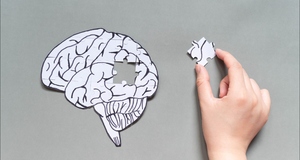Featured Article:Memory Replacement, Confabulation, and Repression: Remembering Creatively
By
2010, Vol. 2 No. 10 | pg. 1/1
KEYWORDS:
The specific purpose of this paper is to discuss some of the factors that would permit an individual to dissociate himself from his true identity, including at a minimum threshold the change in knowledge of some personal events. It is not required that a person believe he is superman to have dissociated from his true identity; all that is required to fit the definition is for the person to blot out a memory of a single event and replace it with another. If someone goes to the store and buys apples yet distinctly remembers buying pears, this would be a perfect example of the phenomenon. With this scenario in mind, this paper asks: what could make a person replace an existing memory with a new one? The two main concepts involved in this discussion are confabulation and repression. A secondary factor called the “misinformation effect” can provide additional elucidation on the subject. Confabulation is the falsification of memory in which gaps in recall are filled by fabrications that the generating individual accepts as fact (APA, 2006). Patients with confabulatory disorders have been known to fabricate information, remember the confabulation, be presented with proof of the truth and continue to believe their initial confabulation. Sometimes this disparity causes them to produce a secondary confabulation to justify the first one (Gilboa et al., 2006). The process of secondary confabulation brings to mind a tongue-in-cheek witticism attributed to a fictitious philosopher who observed that “No set of mutually inconsistent observations can exist for which some human intellect cannot conceive a coherent explanation, however complicated”. Repression is a psychological defense mechanism in which painful experiences are removed from consciousness (APA, 2006). A low intensity form of confabulation is a very common phenomenon that can be best observed through the children's game of “broken telephone”. One child whispers a phrase in another's ear and due to noise from fidgeting and giggling the recipient receives only a portion of the original message intact. The receiving child must then translate the garbled message into a coherent phrase and will attempt to infer the first child's intention. More often than not this inference will be incorrect and a similar sounding, but corrupted message will be transmitted. When the second child tries to edit the garbled portions of the message into something coherent he is confabulating: skipping over the unintelligible phonemes leaves gaps in the word; the new phonemes that make the word different are pure fabrications to fill in these gaps in his recall. The addition of new phonemes is an example of provoked confabulation.Frederick Bartlett was a British psychologist who worked in the period following World War I. His work is significant in that he was one of the first to study the combination of confabulation and repression in some form. One of his other interests was anthropology and he wanted to study similarities and differences in cultures through the differences in very similar folk tales (Bartlett, 1920). Many cultures, for example, have stories about the creation of the world or of a great flood that destroyed everything except for a family in a boat with animals. He surmised that over generations of retelling the original story had become corrupted, hence the differences in the legends. Bartlett was one of the first researchers to study confabulation. To simulate the transmission of a folk tale he first adapted a Native American folk story entitled The War of the Ghosts. The adapted version of the story was very short but contained a lot of confusing language: it used many unfamiliar words, much vague language, did not make clear which characters were speaking and was overall very difficult to read. Bartlett had subjects read the story and asked them to write down what they remembered at various intervals, sometimes extending to months, afterward. He noticed a pattern in the sort of corruptions and with the help of observations about the subjects during the reproduction sessions came to the conclusion that people have a concept about how things should be and that images that contradict that schema are uncomfortable and are quickly amended to less offensive images. The jerky flow of the narrative was very uncomfortable for the subjects and was often “corrected” with both errors of omission and errors of commission (Bartlett, 1928). The conclusion that the presentation of confusing material often results in errors of commission has been corroborated in more recent controlled experiments (Loftus et al., 1978). This phenomenon is called the misinformation effect. One of the first things Bartlett noticed was that his subjects felt a need to “rationalize” the experience: they needed to integrate the confusing information into their schema of the world in a way that the inconsistencies of the story would disappear and there would be no more nagging questions. Many subjects simply remarked that the story was “not English” or “a dream”. One exemplary subject passed the story off as “a murder concealment dream” and in his subsequent reproductions, corrupted the story to better fit the schema he had established. Brewer and Treyens set up an experiment to show the effects of schema congruity on memory. The experimenters made individual subjects wait in their office for a short while and then took them out and asked them to list as many objects that were in the office as they could. The objects that fit the schema of the office were remembered by a greater number of subjects than the objects unusual for an office were (skull, picnic basket, bottle of wine). Some office schema objects that had not been present were also listed by many subjects (Brewer & Treyens, 1981). An experiment by Attali et al. further demonstrated Bartlett’s findings that incongruity of experience with the existing schema, rather than mere gaps in knowledge contribute to confabulation. The experimenters had three kinds of information for Alzheimer’s and non-Alzheimer’s subjects to hear and be tested on: commonly known fairy tales, brand new fairy tales, and familiar fairy tales that have been altered in content to clash with the original story i.e. Goldilocks enters a house belonging to dogs and eats all of their spaghetti. The results were that in both groups there was more confabulatory and “I don’t know” responses for the altered fairy tales than for the completely knew fairy tales, which would contain more gaps in knowledge. This experiment shows that gaps in memory AND schema conflict contribute to confabulation and forgetting (Attalli et al., 2009). More potent forms of confabulation are less common and are associated with memory loss conditions, primarily Alzheimer's Disease (AD), Korsakoff's Syndrome (KS) and various strokes and aneurysms in the brain. Confabulation was first described in 1887 by Russian neurologist Sergei Korsakoff concerning certain heavily alcoholic patients who often made up anecdotes about their past (Borsutzky et al., 2008). As a result of brain damage from malnutrition and alcoholism, KS patients have severe memory impairments. Patients often develop both anterograde and retrograde amnesia (Korsakoff's Syndrome, 2006) which often leads to a feeling of temporo-spatial distortion (Kopelman, 2009); about a quarter of KS patients require hospitalization. These patients have difficulty connecting present experiences with past ones. Since their memories of events are full of holes, KS patients are unable to coherently recall even personal events yet, when questioned on information they cannot possibly have, they are able to fabricate and believe plausible, but false narratives to fit the questions. They are exceptionally bad at accurately recalling episodic memory but also have impairments in semantic memory (Borsutzky et al., 2008). Most of the early research on confabulation is based on the observation of KS patients (Attali et al., 2009). Work done by M. Kopelman corroborates the long standing theory that there are two distinct forms of confabulation, spontaneous and provoked, with different etiologies. Spontaneous confabulations are formed from scraps of real memories that are not temporally linked to other events. The spontaneous confabulator tries to stitch these scraps together into a fabrication. Since these scraps have been taken out of context before the fabrication, spontaneous confabulations are very inconsistent and incoherent. If it could be physically represented, a spontaneous confabulation may resemble a quilt. In some contexts, spontaneous confabulation is also called primary confabulation. Provoked confabulation differs from spontaneous confabulation in that the fabrication is based off of temporo-spatially established material; it is like a patch over a hole in a garment. (Kopelman, 1987). Provoked confabulation is sometimes known as secondary confabulation because it is the type of confabulation that a patient makes when he believes a primary confabulation, is presented with the truth, and must reconcile the two sets on information. Temporo-spatial establishment is not the only factor in confabulation. This is evidenced by semantic confabulations: confabulations whose nature does not involve events, the definition of a word or a piece of trivia for instance. The existence of semantic confabulation demonstrates that poor memory retrieval is at least partially responsible for confabulation (Gilboa et al, 2006). In both types of confabulation under either explanation, the final fabrication will be based around some pre-existing schemata; the scraps of memory in spontaneous confabulation are highly fragmented but they do provide a schema of sorts. Though it is impossible to perform the necessary background checks on KS patients to verify on any more than an anecdotal level, that spontaneous confabulations are based off of actual experiences, there is documented evidence to indicate that this is indeed the case (Attali et al., 2009; Borsutzky et al., 2008). Oftentimes a subject’s only intact representation of an event or concept is his schema of it; these schemata serve as a scaffold (Gilboa et al., 2006) for memory reconstruction. The immediate acceptance or rejection of a statement is proportional to its conformity to the schema. The spontaneous nature of spontaneous confabulators is usually due to severe impairment of memory functions and thus spontaneous confabulation is not suitable for the use as the mode of confabulation needed to answer the question of how otherwise normal people can replace and accept confabulated memories in place of natural ones. Even if a subject were to spontaneously confabulate a retelling of an event, they would probably lack the memory capacity to remember it. It is more favorable to hold provoked confabulation, a “normal response to a faulty memory” (Kopelman, 1987) as a more likely method. The discussion at the end of Gilboa et al. highlights a pair of mental systems that can help explain the process of the acceptance or rejection of an experience or a memory as true. The first is the feeling of right, which is established by comparing the event to a schema. These schemas can change based on setting and framing in response to a person’s drive to achieve a goal, which is most evident in autobiographical exercises. (Conway, Plydell-Pearce, 2000). This is the system behind “gut feeling” responses. The second system is a more advanced system that checks the new event against old memories. A new event may not necessarily significantly clash with a schema, but may be factually wrong. This system, the monitoring system, cross references new material with the corpus of previously accumulated knowledge. Because many confabulators do not have good memory retrieval, either due to faults in the retrieval process or due to the quality of the memories’ original encoding, this system will not filter out incorrect statements. All the confabulators are left with is the feeling of right response. When normal people say they make a gut decision, they are still comparing the available responses to their corpi of knowledge; their gut decisions are potentially more accurate than confabulators’. The confabulator is more vulnerable to accepting new information as true because they do not have as much capacity to filter out garbage. Gilboa demonstrated this filter malfunction by feeding subjects semantic statements that they must accept or deny; confabulators tended to accept these statement indiscriminately with a strong feeling of right. Up to this point, this paper has summarized some of the evidence that points to the ability of the mind to unconsciously create new material to fill in gaps. Most people do not suffer from pathologies that tend to give rise to significant gaps in memory. The next part of this paper will discuss how gaps can be created in a string of memories through the process of repression. The concept of memory repression was first described by Freud in 1915 as a “banishment of unacceptable thoughts, feelings or wishes”. (Repression, 2001). That that is “unacceptable” is to be defined as that which cannot be assimilated into the repressor's schema. The concept of repression has been the center of a foggy debate over the authenticity of “False Memory Syndrome”. The original “case” of FMS was when a woman under hypnosis allegedly uncovered a repressed memory of her father sexually abusing her. The parents championed the cause that the therapist planted the false memory in the daughter's mind when she was in a highly suggestible state. The majority opinion from the psychological community is that there is a dual possibility of the memory being true or false and cannot be verified without external corroborating evidence (Colangelo, 2009). In the APA's statement summarizing their neutrality policy towards FMS, they raised the issue of memories being affected by questioning (APA, 1993). Memory manipulation by questioning schemata is an important issue in forensic psychology. Eyewitnesses who confer with other eyewitnesses who have emphasized different aspects of an event may make themselves less reliable. Witnesses will pick up on the differences in testimony and try to assimilate the incongruity into the schemata of his testimony, polluting it (Roedigger et al., 2001). When the patient undergoes hypnosis and enters that suggestible state, things the therapist says, objects in the therapist’s office and still a third set of things that the patient associates with the other two classes all provide an inventory of possible pollutants to the “testimony” of the patient's memory. Bartlett briefly touched upon this issue in 1928 but did not further investigate it (Bartlett did not dismiss it, though). After one reproduction a subject remarked that he had “a sort of feeling that there was something about a rock, but [he couldn't] fit it in”. The subject concluded that there was no rock in the story (there wasn't). In the reproduction two months later the subject had incorporated the rock into the story (Bartlett, 1928). By thinking about the rock and weighing the pros and cons of its inclusion, the subject had incorporated the possibility of a rock being in the story. Repression can create holes in an individual's memory. Confabulation, suggestion and the memory effect can fill these holes with plausible filler material that fits the patient's schemata. In the example of Bartlett's rock a gap in memory was created by forgetting. The subject's mind knew that there was a hole and other bits of information in it confabulated to form the image of the rock. Although the subject at first dismissed the presence of the rock, he had subjected himself to the suggestion effect: his opponent in his inner dialogue over whether to include the rock took the place of the second eyewitness. The slightly reinforced schema of a present rock was then enough to serve the basis for a provoked confabulation and include the rock in the story. The well known phenomenon of psychiatrically healthy people believing that they have been abducted and molested by extraterrestrials are more recognizable examples of the case of a person replacing an actual experience with a false one. The memory that they were taken up is a false replacement of a more mundane experience of rogue stimuli acting on the unconscious nervous system. As there is little evidence to support the presence of extraterrestrial invaders, the only explanations left to justify these experiences are that a given abductee is either lying or confabulating. The abduction confabulation may be based off of an element in a dream (either remembered from the dream stage or actively intruding into consciousness) and elaborated upon by other elements consistent with a cultural schema (McNally& Clancy, 2005). Because this interpretation is based on the subject's schema, it may not be filtered out by the feeling of right mechanism and said subject will believe that the constructed memory feels right. This feeling will be eradicated by the monitoring mechanism, that everyone knows that there is no such thing as aliens, and be repudiated by most people. Those who believe in a personal alien abduction may have a less proficient monitoring mechanism and be unable to reject this nonsense. In summary, various properties of confabulation can construct a false reality out of memory gaps and mental schemas. Defects in filtering mechanisms can allow these mistakes to be accepted. Conflicting information and subsequent memory repression via the misinformation effect can cause deletions in memory that induce provoked confabulation. ReferencesAmerican Psychiatric Association (1993, December, 12). Statement on Memories of Sexual Abuse [Press Release] Retrieved from , March 4, 2010 Attali, E., De Anna, F., Dubois, B., Dalla Barba, G (2009). “Confabulation in Alzheimer's disease: poor encoding and retrieval of over-learned information”, Brain, 132, 204-212 Bartlett, F.C (1920). “Some Experiments on the Reproduction of Folk Stories”, Folk-Lore 31:30-47. Bartlett, F.C (1928). “An Experiment Upon Repeated Reproduction”, Journal of General Psychology Borsutzky, S., Fujiwara, E., Brand, M., Markowitsch, H (2008). “Confabulations in Alcoholic Korsakoff Patients”, Neuropsychologia, 46:13, 3133-3143. Brewer, W.F., & Treyens, J.C (1981). “Role of schemata in memory for places”. Cognitive Psychology, 13 , 207-230. Colangelo, J (2009). “The Recovered Memory Controversy: A Representative Case Study”. Journal of Child Sexual Abuse, 18:1, 103-121. Conway, M., Pleydell-Pearce, C (2000). “The Construction of autobiographical memories in the self-memory system” Psychological Review. 107(2).: 261-288. Confabulation (2006). APA dictionary of psychology. Washington, D.C.: American Psychological Association. Gilboa, A., Alain, C., Stuss, D., Melo, B., Miller, S., Moscovitch, M (2006). “Mechanisms of spontaneous confabulations: a strategic retrieval account”. Brain 129:1399-1414. Kopelman, M (1987). “Two Types of Confabulation”, Journal of Neurology, Neurosurgery & Psychiatry, 50, 1482-1487 Kopelman, M., Thomson, A., Guerrini, I., Marshall, J (2009). “The Korsakoff Syndrome: Clinical Aspects, Psychology and Treatment”. Alcohol & Alcoholism, 44:2: 148-154. Lee, E., Akanuma, K., Meguro, M., Ishii, H. Yamaguchi, S., Meguro, K (2007). “Confabulations in remembering past and planning future are associated with psychiatric symptoms in Alzheimer’s disease”. Archives of Clinical Neuropsychology, 22: 949–956 Loftus, E, Miller, D, Burns, H (1978). “Semantic integration of verbal information into a visual memory”. Journal of Experimental Psychology: Human Learning and Memory, 4, 19–31 McNally, R., & Clancy, S (2005). Sleep Paralysis, Sexual Abuse, and Space Alien Abduction. Transcultural Psychiatry, 42(1)., 113-122. Repression (2006). APA dictionary of psychology. Washington, D.C.: American Psychological Association. Roediger, H. III, Meade, M., Bergman, E.(2001). Psychonomic Bulletin & Review, 8:2, 356-371 Suggested Reading from Inquiries Journal
Inquiries Journal provides undergraduate and graduate students around the world a platform for the wide dissemination of academic work over a range of core disciplines. Representing the work of students from hundreds of institutions around the globe, Inquiries Journal's large database of academic articles is completely free. Learn more | Blog | Submit Latest in Psychology |


















